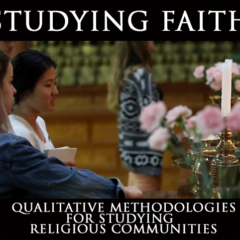Throughout this manual we refer to studying religion from the perspective of a social scientist. What makes the perspective of a social scientist so unique? In fact, why do we make the distinction at all? Is a social scientist’s perspective on a religious group so much different from that of the group’s leader, a journalist, someone who lives down the block from the group, or a person who reads about the group in the newspaper?
Though there is a lot of debate about how “scientific” sociological and anthropological studies really are (especially if they are qualitative), one of the characteristics of social scientific research is systematic data collection. Social scientists adhere to specific and rigorous sampling methods to try to understand the responses of a large group or populations.
An important tool that separates a social scientific study of religious groups from other perspectives is the use of analytical frameworks to guide the research. We do not provide an in-depth discussion of all the potential frames, theories or lenses you could use in your project (we suggest referring to your Introduction to Sociology or Anthropology textbook for further information). Our advice is that you choose a framework that highlights an interest of your own.
You could look at a congregation as a social institution, located in a place. By definition it interacts with the schools, police department, neighbors and other religious groups and is in part shaped by the economy, the housing market and its immediate material surroundings. This sort of study employs an ecological framework as it views the congregation as a living social organism that operates in a diverse, dynamic habitat. But the ecological approach is not the only option. The same congregation could be studied and analyzed with an emphasis on culture, race or gender. The key is to choose a lens that best fits both you and the group.
Why must researchers apply appropriate theoretical frameworks to their findings?
Sociologist Richard Flory discusses how to apply theoretical frameworks to analyze and make sense of qualitative data.
Here are three reasons why using frameworks is useful:
Empiricism
Theoretical frameworks help to detach the research from the researcher’s personal experience with a religious group. For example, imagine a researcher who grew up in a Mormon family in a small, predominantly Mormon city just south of Salt Lake City. The researcher is still a practicing Mormon, and for her dissertation, she is studying a Mormon Temple in rural Samoa. There is nothing inherently wrong with a practicing Mormon studying other Mormons; in fact many researchers are interested in their own faith traditions. Still, this researcher will face the challenge of trying to study this group as objectively as possible. Studying this rural temple in Samoa through a theoretical framework may help her to filter out her own personal experience from her observations of the group she is studying.
Generalizability
Theoretical frames help to produce generalizable results. This is important because no two religious groups are exactly the same. These groups comprise individuals with unique personal histories and personalities. The members live their lives in very particular relationships with others in their community, so each religious group is different from the other. Continuing with the example of the researcher in rural Samoa, how can the social scientist make claims about global Mormonism or even Mormonism in Samoa if every temple is different? The answer is that it is not easy to do so, but examining groups through a theoretical lens helps to highlight data and analysis that can be used to make these sorts of claims.
Scholarly contribution
By using theoretical frames, the researcher is able to contribute to larger bodies of academic research. If the researcher in Samoa is interested in understanding masculine identities in the Mormon temple she is studying, she will be able to use the results of her research to contribute to other academic work on gender or masculine identity. She will be able to not only contribute to decades of published work on this topic, but also use the work of others to guide her own project. She may have read an interesting article about how some men in northern Idaho construct gendered identities by practicing mixed martial arts. She can use the conclusions from this study in a very different cultural context to help her work on Mormon temples in rural Samoa.
Make no mistake, situating your research into these larger theoretical frameworks is not an easy task; even seasoned researchers can struggle with the process. In fact, this is one of the most difficult aspects of studying religion from a social scientific perspective, but we think it is also one of its most useful aspects. In most introductory Anthropology and Sociology courses, the instructor will tell the class that one of the primary purposes of the discipline is to “make the familiar strange and the strange familiar.” This can be an awkward, discomforting and agonizing process with any subject, but particularly when studying religion.
Once again in Samoa, if the Mormon researcher is using a gender frame to study the temple, she will have to observe and analyze prayers, worship songs, marriage ceremonies and sermons by paying special attention to gender roles and norms. This will likely be a very different experience for her than when she prayed, sang, listened to sermons and attended weddings simply as a practicing Mormon.
Nalika Gajaweera was a senior research analyst with the USC Center for Religion and Civic Culture through 2023.
Andrew Johnson is a contributing fellow with the USC Center for Religion and Civic Culture.

